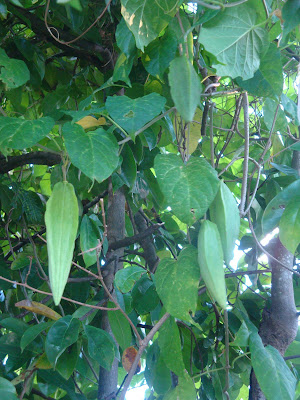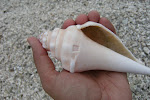I noticed a vine growing in my friend's backyard some time ago. It caught my eye since the flowers were new to me. I messed up my digital camera a few months ago so I couldn't take any pictures. I remember a long time ago before the advent of digital cameras that I used to record things in a journal. I decided to commit what I saw to memory and draw what I could in a used notebook using a pen and colored pencils.
 I took some time trying to remember details of the vine, flowers, seed pods and leaves. After reviewing later, I noticed that there were a lot of inaccuracies in my notes. Oh, well!A few days later, I was able to borrow my friend Ashley's camera but the flowers had all fallen off and the seed pods were all gone! I was pretty frustrated to say the least. I decided to ask the neighbor to see if he knew anything about the mystery plant. Good thing I asked because I found out that he was responsible for my missing samples.
I took some time trying to remember details of the vine, flowers, seed pods and leaves. After reviewing later, I noticed that there were a lot of inaccuracies in my notes. Oh, well!A few days later, I was able to borrow my friend Ashley's camera but the flowers had all fallen off and the seed pods were all gone! I was pretty frustrated to say the least. I decided to ask the neighbor to see if he knew anything about the mystery plant. Good thing I asked because I found out that he was responsible for my missing samples. He said that the Filipinos use the plant as a vegetable and the Ilocanos called them bagkobagkong and that the Pangasinans called them, abopoyat. He said that you can simply boil the seed pods and eat them like that. I imagined that they looked liked Psophocarpus tetragonolobus or winged beans (sigarillas in Tagalog; sigidiyas in Chamorro).
A few weeks later, there were more flowers and a few more seed pods. I just had to borrow Ashley's camera again. Recording what they looked like in pictures was just the beginning: Identifying them would take longer I figured.




 Fresh leaves. The old ones turn a dull yellow color.
Fresh leaves. The old ones turn a dull yellow color. It is a good thing that plants and animals are grouped and classified according to similarities in their parts. The best clue I had to their identity also came from the neighbor who ate them! I didn't have a chance to see the pods mature so that I could look at the seeds, so I asked him if he knew what they looked like. He said that they were like cotton! That was a great clue because I thought that the fruits would contain "winged" seeds like the African tulip or gold or trumpet tree since their pod looked like dehiscent pods (pods that open when they mature and dry to disburse seeds).
It is a good thing that plants and animals are grouped and classified according to similarities in their parts. The best clue I had to their identity also came from the neighbor who ate them! I didn't have a chance to see the pods mature so that I could look at the seeds, so I asked him if he knew what they looked like. He said that they were like cotton! That was a great clue because I thought that the fruits would contain "winged" seeds like the African tulip or gold or trumpet tree since their pod looked like dehiscent pods (pods that open when they mature and dry to disburse seeds).I know that milkweeds in the dogbane family had similar structures in seeds and seed pods, so it wasn't long before my Internet searches led me to upon the genus Hoya, or wax vines. This was a whole new world for me because I never knew that they had such a big following. People collect them like orchids and there are hybrids and highly sought after varieties.
A few more searches revealed that Telosma flowers are eaten as vegetables but only found one site about them in the from the Philippines. It's entitled Fruits & Vegetables of the Forest and calls Telosma precumbens, babagkong. The flowers are collected and eaten, and the site claims that these wild vegetables are more nutritious than the farmed vegetables (although more expensive). This is most likely the information that I was looking for! It also states that the vine flowers during the rainy months of June through December.
 Here is a picture of the collected flowers from that website
Here is a picture of the collected flowers from that website(Food & Fertilizer Technology Center for the Asian and Pacific Region).
I also found some information on the Telosma that is eaten as a vegetable in
 This photo is from this blog and they have pictorials and the recipe in Thai.
This photo is from this blog and they have pictorials and the recipe in Thai.A Telosma native of

This picture of a gorgeous Pakalana and Pikake lei is from Sweetblossomshawaii.com
I found also found a plant survey online done in Guam's War in the Pacific National Historic Park. According to the article, they found Pakalana where the Piti Guns are located, and according to Dr. Lynn Raulerson (my old biology professor! Wootwoot!), they are most likely escapees from someones property that became naturalized there.
A Legend
It is said that the Pakalana’s fragrance becomes more intense in the evening. In fact the Chinese name, Ye Lai Xiang (夜来香), literally means, “fragrance comes through the night”. There is even a Chinese legend that tells of a fierce army that lay siege to a castle. As the day grew late, the Pakalana flowers that lined the countryside leading up to the castle started opening and sending out their fragrance. The later it became, the more intense the Pakalana’s perfume lingered in the air consequently, calming the soldier’s down. By nightfall, the soldiers were disarmed by the fragrance giving up the siege and the castle was, in the end, saved by the Ye Lai Xiang!
DRAW!
Well that is my story about my mystery vine. I hope you liked talking stories with me once again. I also hope that there is inspiration in this that taking notes the old fashion way is still a good way to record things that are important, and that all it takes are observation, some paper and something to write with. Plus, its fun to doodle stuff! I always appreciate a good Star Wars doodle!

The Beachcomber
P.S. If you want to research more Telosma cordata has other synonyms and many common names: Telosma minor, Pergularia minor, Oxystelma ovatum, Telosma odoratissima, Asclepias cordata, Pergularia odoratissima, Pakalana vine, Tonkin Jasmine, Cowslip Creeper, and Chinese violet. Sorry, but I could not find anything else about Telosma precumbens or if it is another synonym to T. cordata.


4 comments:
Very cool! I like your drawings!
Many thanks! I grew up with this flower in South India and had no idea how to identify it because I did not even have a name until I chanced upon your post. And now you have given me more names for it than I know what to do with!
Not only that, I always thought the flower was poisonous and that it's appearance and perfume seemed toxic. It's wonderful to know that it's an edible vegetable and is considered fragrant! Just goes to show that one can be prejudiced about anyone and anything, even flowers and that one must be careful what one believes!
Post a Comment